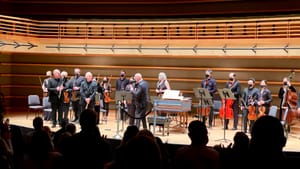Stay in the Loop
BSR publishes on a weekly schedule, with an email newsletter every Wednesday and Thursday morning. There’s no paywall, and subscribing is always free.
A Baroque tour of Europe
The Chamber Orchestra of Philadelphia presents Brandenburg & the Baroque

The Chamber Orchestra of Philadelphia threaded a needle between three countries in a program dedicated to early modern music, given under the omnibus title Brandenburg & the Baroque. In doing so, they showed how much life still resides in these compositions, which are too often regarded by contemporary listeners as overly fussy or merely decorative.
Small ensembles tend to excel in Baroque works, which were scored for more modest forces than one would expect from a modern-day orchestra. I find it almost invariably disappointing when a large outfit attempts to slim down its sound to create something akin to historically informed performance, where the players tend to be uncomfortable in an unfamiliar idiom and the result sounds quaint rather than vital. When it comes to a chamber concert, though, these selections fit the intimate setting like a glove.
What Vivaldi taught Bach
The level of familiarity and ease exhibited by conductor/harpsichordist Jeffrey Brillhart and his musical forces was evident from the very beginning. Although J. S. Bach took pride of place in the program’s title, only one of his compositions was heard, saved for the last slot of the hourlong performance. But his influence—and the influence of foreign contemporaries on his own work—could be heard throughout.
In fact, Antonio Vivaldi’s Concerto Grosso in D Minor, Op. 3, No. 11 was so loved by Bach that he transcribed it for his own instrument, the organ, shortly after its premiere. Vivaldi himself was a violin virtuoso, and he brought originality and a sense of deep tension to the double solos for the instrument that anchors the piece.
The composition resists an aura of sameness, with interesting shifts in dynamics, orchestral colors, and tempi throughout. The rich violin duet that opens the work, played here with chestnut tone by Luigi Mazzocchi and Natasha Colkett, picks up weight when echoed by cello and harpsichord. Brillhart, conducting from his keyboard, kept the pace flowing effortlessly throughout, while creating a real sense of variation on an instrument that can easily sound monochromatic. At the conclusion, I realized for the first time what a debt Bach’s own Double Violin Concerto, composed 20 years later, owes to Vivaldi.
Rameau and Bach
Brillhart interspersed dance interludes from three operas by Jean-Philippe Rameau throughout the concert. These brief selections underlined the stylistic differences of French Baroque to its German and Italian counterparts—you could draw a straight line to the lushly ornamental but psychologically probing music of Debussy or Poulenc. The string texture shimmered in Les Boréades but remained satisfyingly unblended, allowing a contrast between lively exuberance and impending doom. The Aria for the Muses from Le temple de la Gloire, which often sounds blandly pretty, took on real character and weight, with wind instruments forcefully breaking into the action.
The flute dominates Bach’s Fourth Brandenburg Concerto, and here, soloists Edward Schultz and David DiGiacobbe alternated between a light, pastoral sound and a sense of urgency that matched Mazzocchi’s insistent solo violin line. Brillhart smartly played with dynamics by altering the placement of the wind soloists across the three movements, having them move to the rear of the stage in the Andante, where they seem to be calling to the violin from a great distance. Mazzocchi achieved the racing intensity of Bach’s violin writing, though at times he brushed up against Brillhart’s more moderate tempo.
Academic works
The only disappointment came in the form of two works by Giovanni Battista Sammartini, often called the father of the modern symphony. One can clearly hear the birth pangs of the art form in his fleet compositions, but they lack the style and development of those who succeeded him. To compensate, they require a blood-and-guts approach that throws the music up in the air and lets it spin. Brillhart’s interpretation, however, was rather staid. There is a reason, perhaps, why Sammartini is remembered largely in academic terms, while Bach, Vivaldi, and Rameau all still hold places in the active repertory.
What, When, Where
Brandenburg & the Baroque. Works by Antonio Vivaldi, Jean-Philippe Rameau, Giovanni Battista Sammartini, and J. S. Bach. Conducted by Jeffrey Brillhart. Chamber Orchestra of Philadelphia. $29-$105. February 20 and 21, 2022, at the Kimmel Cultural Campus’s Perelman Theater, 300 S. Broad Street, Philadelphia. (215) 893-1999 or chamberorchestra.org.
All audience members aged 5 years or older must show proof of full Covid-19 vaccination to enter the Kimmel Cultural Campus. Children younger than 5 years must provide a negative PCR test taken within 72 hours of a scheduled event. Masks must be worn at all times. Seating is not distanced.
Accessibility
The Kimmel Cultural Campus is an ADA-compliant venue. Patrons can purchase wheelchair seating or loose chairs online, by calling Patron Services at (215) 893-1999, or by emailing [email protected]. With advance notice, Patron Services can provide options for personal care attendants, American Sign Language, Braille tickets and programs, audio descriptions, and other services.
Sign up for our newsletter
All of the week's new articles, all in one place. Sign up for the free weekly BSR newsletters, and don't miss a conversation.

 Cameron Kelsall
Cameron Kelsall